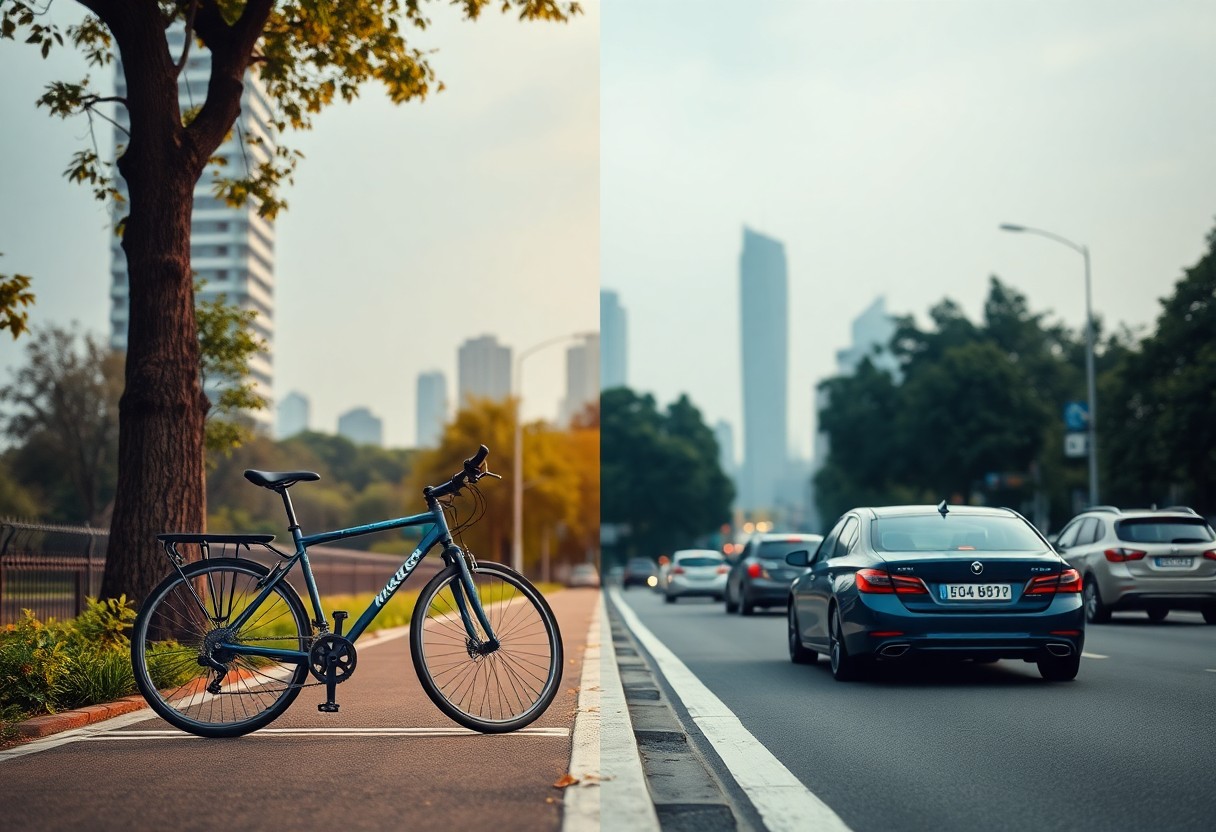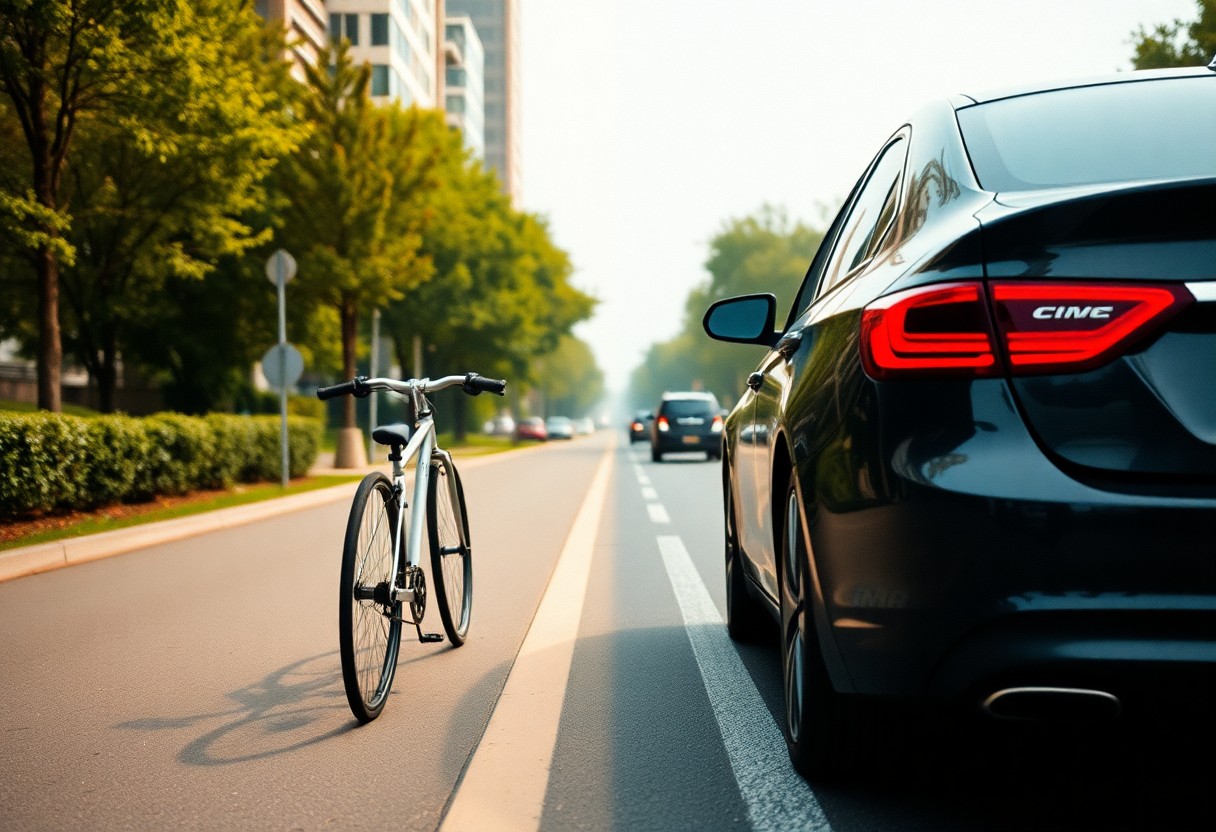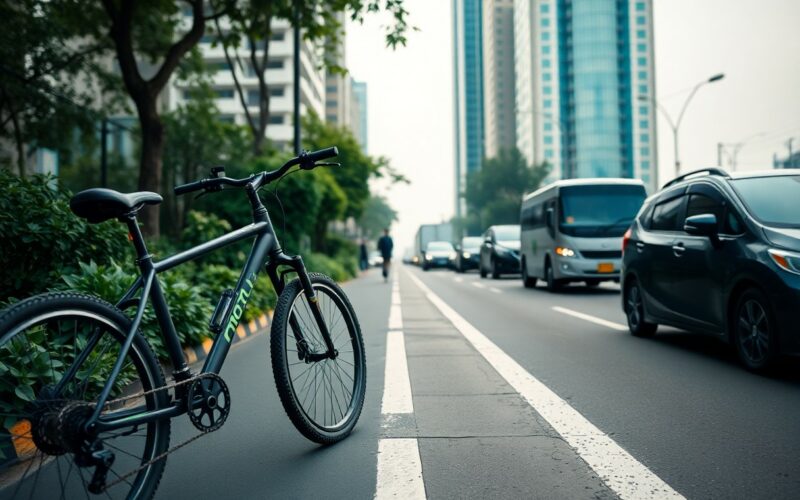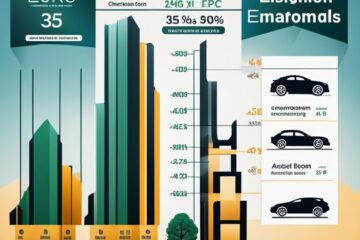Over time, you have likely considered how your daily transportation choices impact the environment. This blog post will help you explore the significant differences between bikes and cars in terms of their environmental footprints. You’ll discover how opting for a bike can lead to a reduction in greenhouse gas emissions, conserve valuable natural resources, and promote your personal health. By understanding these factors, you can make more informed decisions that benefit both your lifestyle and the planet.
Table of Contents
Key Takeaways:
- Bicycles significantly reduce carbon emissions compared to cars, making them a more eco-friendly mode of transportation.
- The production and maintenance of bikes have a lower environmental impact than that of vehicles, contributing to less resource depletion.
- Urban areas designed to accommodate bicycles can lead to reduced traffic congestion and improved air quality.
- Investment in cycling infrastructure can promote a healthier lifestyle, further decreasing the reliance on cars.
- Bicycles require less space for parking and travel, making cities more sustainable and livable when integrated into public transport systems.

Understanding Environmental Footprints
Before delving into the conversation about bikes and cars, it’s necessary to understand what is meant by an environmental footprint. This concept helps you quantify the impact of various activities, products, or modes of transportation on our planet. Grasping the significance of environmental footprints can guide you in making more sustainable choices in your daily life.
Definition of Environmental Footprint
Above all, an environmental footprint refers to the total amount of natural resources and energy consumed by a person, organization, or product, coupled with the waste generated throughout that usage. This understanding can help you see how your actions translate into environmental impacts and guide you toward more eco-friendly decisions.
Additionally, different types of footprints—like carbon, water, and ecological footprints—each reveal different aspects of how our lifestyles affect the Earth. Learning to interpret these metrics can empower you to see the broader implications of everyday choices, making you a more informed consumer.
Measurement Techniques for Footprints
Techniques for measuring environmental footprints have evolved over time, with many methodologies available to assess various impacts. You can use life cycle assessments (LCA), for instance, to evaluate the total environmental impact of a product from raw material extraction through manufacturing and distribution to disposal. Other approaches may involve direct calculations based on energy consumption or resource extraction.
Indeed, some of the most effective measurement techniques often utilize a combination of data sources. You might find that surveys, databases, and ecological modeling work together to provide a comprehensive view of environmental impacts. These diverse methodologies help create a more accurate picture of what you, as an individual or a society, are contributing to the environment.
Key Components of Environmental Impact
The key components that contribute to environmental impact are often categorized into several main areas: energy consumption, greenhouse gas emissions, resource depletion, and waste generation. Each component plays a significant role in shaping the overall footprint of any transportation method, whether it’s a bicycle or a car. Understanding these elements equips you with the knowledge necessary for making conscious decisions that can significantly reduce your ecological impact.
Even a small change in your transportation choices can lead to substantial improvements in these areas. For example, choosing a bike over a car not only reduces your carbon emissions but also contributes less to resource depletion and waste production. Recognizing these key components can motivate you to adopt more environmentally responsible behaviors.
The Environmental Impact of Cars
The impact of cars on the environment is profound and multifaceted. As you investigate into the various aspects of automobile use, it becomes evident that your choices can significantly influence the planet’s health. From carbon emissions to land use issues, understanding these facets helps you comprehend the larger environmental implications of car ownership and usage.
Carbon Emissions
Beside the convenience that cars offer, they are major contributors to your carbon footprint. Cars emit greenhouse gases, predominantly carbon dioxide, which trap heat in the atmosphere and contribute to climate change. Every mile driven in a gasoline-powered vehicle releases an average of around 404 grams of CO2, which adds up quickly over time. Therefore, the more you rely on a car, the more your contributions to global warming increase.
This reliance on cars isn’t just a personal concern; it’s a global dilemma. As millions of people drive millions of cars each day, the cumulative emissions become staggering. To combat this, transitioning to electric vehicles or investing in alternative transportation methods could significantly reduce the impact you have on the environment.
Resource Consumption
Along with carbon emissions, your use of cars also leads to significant resource consumption. Production of vehicles requires vast amounts of natural resources, including metals, plastics, and fossil fuels. According to studies, the manufacture of a single car can consume nearly 40 tons of minerals, fossil fuels, and water combined. These resource needs not only deplete the earth’s stock but can also lead to habitat destruction and biodiversity loss.
At the end of their life cycle, cars can pose additional challenges. Many of the materials used in construction are not biodegradable, leading to substantial waste issues. It is necessary for you to consider not only the operational costs of vehicles but also the long-term ecological consequences associated with their production and disposal.
Pollution and Health Effects
Alongside environmental degradation, the health effects of car emissions are alarming. Urban areas are often shrouded in air pollution due to the high concentration of vehicles. This pollution exposes you and your community to harmful pollutants, which can lead to respiratory issues, cardiovascular diseases, and various other health problems. The detrimental effects of air quality often disproportionately affect vulnerable populations, including children and the elderly, making it a pressing public health issue.
For instance, studies have shown that areas with heavy traffic tend to have higher rates of asthma and related diseases. Choosing alternative modes of transportation, such as biking or public transit, can help alleviate these health risks, promoting not only a cleaner environment but also a healthier community.
Land Use and Urban Sprawl
After examining emissions, resource use, and health implications, it is necessary to highlight the impact of cars on land use and urban sprawl. The rise of the automobile has significantly altered how cities are designed, often leading to sprawling suburbs characterized by low-density development. This pattern of urban expansion forces you to travel longer distances, leading to greater reliance on cars and further perpetuating environmental harm.
Understanding this cycle is crucial. The more land is dedicated to roads and parking lots, the less is available for sustainable practices such as parks or green spaces. Reducing car dependency can help encourage smart growth initiatives, fostering more sustainable communities that prioritize public transportation, biking, and walking.
The Environmental Impact of Bikes
Keep in mind that cycling has a profound effect on the environment, representing a sustainable mode of transportation that actively reduces your carbon footprint. Choosing to ride a bike instead of driving significantly lowers carbon emissions, making a considerable difference in combating climate change. In fact, studies suggest that switching from a car to a bike can cut your annual carbon emissions by up to 2,000 pounds. This reduction is not only beneficial for the planet but also contributes to improving air quality in urban areas, which affects everyone’s health.
Carbon Emissions Reduction
Across numerous cities around the world, there is a growing acknowledgment of the environmental benefits of adopting cycling as a primary mode of transport. By opting for a bike, you are eliminating the emissions associated with fossil fuel use, thus playing an integral role in addressing air pollution. This shift not only benefits the earth but also promotes healthier communities, as cleaner air is linked to reduced health risks.
Minimal Resource Consumption
Minimal resource consumption is another area where cycling excels over driving. A bicycle requires significantly fewer resources to manufacture and maintain compared to a car. With the production of bicycles using less energy and fewer raw materials, it’s clear that choosing to bike conserves valuable resources. Furthermore, a bike doesn’t require gasoline; this further reduces dependence on non-renewable energy sources.
Consumption of resources is substantially lower when supporting cycling culture. For instance, a bicycle generally requires less than 1% of the materials needed to produce a car. As a result, every bike can be seen as an environmentally friendly and sustainable alternative to a motor vehicle, fostering a more responsible approach to resource use.
Health Benefits and Pollution Reduction
Carbon emissions are not the only concern related to transportation; your choice to ride a bike directly impacts public health as well. Regular cycling promotes physical health, reducing the risk of chronic diseases such as obesity, diabetes, and heart problems. You’re not just benefiting yourself by staying fit; you’re also playing a role in reducing congestion and airborne pollutants resulting from automobile traffic.
Environmental awareness should guide your transportation choices. By integrating biking into your daily routine, you not only cut down on harmful emissions but also contribute to a healthier population. Roadways filled with cars contribute to significant air quality issues, while cyclists create a more serene atmosphere in your community.
Space Utilization and Urban Planning
Emissions from vehicles take up a considerable amount of urban space, leading to congestion, noise, and a general decline in quality of life. By shifting to a bike-friendly mindset, you encourage local planners to invest in infrastructure that better accommodates cyclists, ultimately leading to enhanced city layouts that prioritize green transportation over cars. This transformation can increase the efficiency of urban areas, providing more space for parks, pedestrian pathways, and community spaces.
This transition to bike-centric urban planning can have long-term positive impacts for you and your city. Dedicated bike lanes not only improve safety for cyclists but also alleviate road traffic, making it easier for everyone to navigate their environment. As cities embrace more sustainable modes of transportation, the organized use of space can enhance urban living, making it a more enjoyable and environmentally-friendly place to reside.
Comparative Analysis: Bikes vs. Cars
Many studies reveal significant benefits when you exchange your car for a bike, even just part-time. For instance, Ditching the car for walking or biking just one day a week can lead to a reduction in carbon emissions while enhancing your physical health. This shift not only promotes a greener planet but also offers numerous advantages for your well-being.
Environmental Impact Comparison
| Bikes | Cars |
|---|---|
| Produces zero emissions during use | Generates high levels of CO2 and other pollutants |
| Minimal resource consumption in manufacturing | Requires extensive resources for production and fuel |
| Encourages sustainable urban development | Contributes to urban sprawl and pollution |
Life Cycle Analysis of Vehicles
Any thorough analysis of the environmental footprints of bikes and cars must consider their entire life cycle, from manufacturing to disposal. The resources and energy consumed in the manufacturing of vehicles can vary widely, with cars often requiring more metals, plastics, and chemicals, leading to a higher initial environmental cost. Furthermore, bikes boast a longer lifespan in many cases, while cars can be subjected to more frequent upgrades or replacements due to technological advancements.
Post-use disposal is also an necessary factor in life cycle analysis. Bikes generally have a lower impact in this area as their components are easier to recycle or repurpose. In contrast, the complex systems found in cars often lead to increased waste and environmental damage when they are finally retired. Therefore, overall, when evaluating their life cycle impact, bikes present a more sustainable choice for transportation.
Community and Social Impacts
The societal implications of choosing bikes over cars can be significant. Using a bicycle often fosters a stronger sense of community, as riders are more likely to engage with their environment and other individuals. This involvement can reduce traffic congestion, improve public health, and promote an inclusive atmosphere for pedestrians and cyclists.
Moreover, the shift towards cycling promotes a more active lifestyle, reducing risks associated with sedentary behaviors. By investing in bicycle infrastructure, communities can see increased local business revenue and enhanced quality of life for residents, creating a cycle of benefits that ripple through society.
A key advantage of biking is that it can bring people together, cultivating friendships and community ties. Streets designed with cyclists in mind foster interaction and encourage social gatherings, helping to build a harmonious relationship between diverse community members.
Cost-Benefit Analysis
Across various jurisdictions, the financial implications of biking versus car usage reflect stark contrasts. While the upfront purchase of a car involves significant costs—purchase price, maintenance, insurance, and fuel—bikes require considerably lower investment. Dropping the car for a bike can lead to dramatic savings in insurance premiums and maintenance costs, making cycling a financially attractive option.
With decreased road maintenance requirements and lower healthcare costs from improved public health, the overall financial burden on society is diminished when cycling becomes prevalent. As a final point, choosing to bike over driving holds promising potential for both personal savings and community financial health.
At the same time, when you consider the long-term impact of emissions and health benefits, the financial advantages of using bikes become even more pronounced. With fewer resources spent on car-related expenditures, you can invest in other areas of your life, leading to better economic stability.
Sustainability Goals and Policies
Along with individual benefits, the broader implications of prioritizing biking over car use align well with global sustainability goals. Many city planners are increasingly recognizing the importance of cycling infrastructure, investing in bike lanes and green spaces to encourage citizens to choose cycling as a primary means of transport. This trend supports local and global initiatives focused on reducing carbon footprints and improving air quality.
Policies aimed at promoting biking as a sustainable transit option can significantly alter urban landscapes. Enhancing cycling infrastructure and making it safer encourages more people to make the transition, resulting in substantial reductions in vehicular traffic and emissions.
Community efforts to boost biking and diminish reliance on cars reflect a growing recognition of environmental responsibility and a commitment to creating a healthier future. Developing such initiatives builds the foundation for long-lasting positive change in your local environment.

Case Studies and Real-World Examples
To truly understand the impact of bikes versus cars on the environment, it is imperative to explore real-world examples and case studies that showcase environmental footprints and the outcomes of different transportation choices. The following list highlights some of the most compelling case studies, illustrating the differences in emissions, energy consumption, and overall sustainability:
- Amsterdam, Netherlands: More than 60% of residents commute by bicycle, resulting in a reduction of 2 million tons of CO2 emissions annually.
- Copenhagen, Denmark: With 62% of the population cycling daily, the city has seen a decrease of over 100,000 tons of greenhouse gases per year.
- Portland, Oregon: The city has invested in cycling infrastructure, leading to a 25% reduction in vehicle miles traveled and a significant decline in air pollution.
- Tokyo, Japan: A large-scale push for bicycle commuting has led to a 20% decrease in CO2 emissions due to reduced reliance on cars.
- London, UK: The introduction of bike-sharing programs resulted in a rise in cycling by over 250%, promoting a cleaner urban environment.
Global Cities Promoting Cycling
At the forefront of promoting cycling, cities like Amsterdam and Copenhagen serve as leading examples of how focused investments and policies can redefine urban landscapes. By building extensive cycling infrastructure, such as dedicated bike lanes and bicycle parking facilities, these cities have achieved a remarkable shift in transportation habits. In Copenhagen, for instance, cyclists account for more than half of daily commuters, significantly lowering the city’s transport-related emissions.
Moreover, the cultural acceptance of cycling in these cities highlights the critical role that community attitudes play in fostering sustainable transportation. Events like Copenhagen’s Bike Day encourage and celebrate cycling, reinforcing it as a valuable aspect of daily life. The resulting benefits extend beyond just reduced emissions; they include improved public health, less congestion, and increased quality of life for residents.
Cities with High Vehicle Usage
On the other hand, cities with high vehicle usage demonstrate the adverse impacts of car-centric transportation systems. In cities like Los Angeles, where car culture predominates, the environmental consequences are pronounced. It is shown that the transportation sector accounts for nearly 40% of greenhouse gas emissions in the US, with personal vehicles being a significant contributor. Such reliance on cars leads not only to increased CO2 emissions but also worsens air quality and urban sprawl.
Hence, you should be aware of the stark contrast between car-heavy urban environments and those that prioritize cycling. The high dependency on vehicles in cities like Los Angeles results in traffic congestion, contributing to over 100 premature deaths annually due to air pollution. This highlights the need for effective policy interventions to decrease car usage and promote alternative modes of transport.
Impact Studies from Multiple Regions
RealWorld studies across various regions demonstrate the tangible benefits of biking over driving. Research indicates that a shift towards cycling can lead to a 40% reduction in overall transportation emissions, depending on the local context and infrastructure. For example, a study in Paris found that if 15% of car trips were replaced with bike trips, the city could prevent 300,000 tons of CO2 emissions each year.
Further, cities embracing cycling often see decreases in traffic fatalities and improved mental health outcomes among residents. The data underscores a compelling argument for prioritizing cycling infrastructure in urban planning initiatives, particularly as cities around the globe look for sustainable solutions to combat climate change and enhance urban mobility.
Success Stories and Lessons Learned
Case studies from cities worldwide illustrate the pathway to sustainability through cycling. For instance, Barcelona’s commitment to transforming streets to accommodate bike lanes has resulted in a 65% increase in cycling over five years. This case exemplifies how ecological and health benefits can accompany urban policy changes favoring cyclists.
Learned from these success stories, you can see that investing in cycling infrastructure not only benefits the environment but can also invigorate local economies. As cities witness increased bike usage, they often report higher retail activity and enhanced community engagement. These lessons point towards a promising future where urban centers can thrive while reducing their carbon footprints.

Future Trends and Innovations
Your choice between bikes and cars can significantly shape the environmental landscape of the future. As society becomes increasingly aware of the need for sustainable living, advancements in technology and urban design are moving towards more eco-friendly transportation options. For a deeper understanding, you can explore The Environmental Impact of Electric Bikes vs. Cars, where innovative approaches to transportation are discussed.
Advances in Bicycle Technology
Between electric bicycles, smartphone connectivity, and enhanced safety features, the bicycle industry is witnessing a rapid transformation. Manufacturers are integrating smart technology to improve the riding experience, offering features like GPS navigation, theft detection, and health tracking. These improvements not only make cycling more convenient but also promote it as a viable and appealing alternative to driving, particularly in urban settings.
Furthermore, advancements in materials used for bike construction are making bicycles lighter, more durable, and increasingly efficient. Innovations in aerodynamic designs and multi-speed gear systems enhance performance, allowing cyclists to tackle a range of terrains and distances. As you consider your transportation options, the strides made in bicycle technology might just sway your decision towards cycling, proving it to be an attractive and eco-friendly choice.
Innovations in Automobile Design
Trends in automobile design are shifting towards more sustainable practices, with manufacturers prioritizing electric vehicles (EVs) and hybrid models. These vehicles not only produce lower emissions but also integrate modern technologies such as solar panels and regenerative braking systems to maximize efficiency. While cars have long been seen as synonymous with urban transport, the latest innovations invite you to rethink how cars can coexist with greener alternatives.
Innovations are also focused on making vehicles smarter and more interactive. The incorporation of AI and machine learning allows for improvements in traffic management and route optimization, minimizing fuel waste and emissions. As you weigh the environmental footprints of bikes and cars, these advancements could redefine your understanding of the impact automobiles have on the planet.
Urban Planning and Infrastructure Developments
With the shift towards sustainable transport, urban planning is adapting to support bicycle-friendly environments and reduce the reliance on cars. Cities are beginning to implement more bike lanes, safer crossings, and designated parking spaces, making it easier and safer for you to choose cycling over driving. Moreover, the integration of green spaces within cities not only enhances the aesthetic but promotes healthier living.
Considering the implications of urban planning, it’s evident that the infrastructure developments paving the way for a cycling revolution are vital. Cities that prioritize biking and walking create a more sustainable environment, reducing congestion and lowering CO2 emissions. This paradigm shift invites you to be part of a community that champions eco-conscious choices.
Policy Changes Encouraging Sustainable Transport
Infrastructure is a key factor in promoting sustainable transport initiatives. Governments are increasingly investing in policies that support the usage of bicycles over cars, offering incentives such as tax breaks, subsidies for e-bikes, and funding for cycling infrastructure. These initiatives not only encourage you to consider cycling as a viable transportation option but aim to reshape societal norms surrounding vehicle ownership and reliance.
Sustainable transportation initiatives are crucial for cities aiming to reduce their carbon footprint. By supporting and advocating for policies designed to promote cycling, you contribute to an eco-friendly community, reflecting the collective will for a greener future. Strong policy measures can have a monumental impact, shaping the transportation landscape for generations to come.
Final Words
Drawing together the comparison between bikes and cars, it’s evident that your choice of transportation can have a significant impact on the environment. Bicycles not only reduce greenhouse gas emissions but also consume fewer resources in their production and maintenance compared to cars. By opting for a bike, you are actively contributing to lower air pollution levels and minimizing your carbon footprint. This shift in your mobility habits can lead to cleaner air and more sustainable urban spaces for future generations.
Furthermore, embracing cycling over driving can also promote healthier lifestyles, both physically and mentally. As you pedal through your community, you make a powerful statement about the importance of environmental stewardship. Incorporating more biking into your routine not only benefits the planet but also enhances your well-being and fosters a sense of community. Ultimately, every small change you commit to in how you navigate your surroundings can lead to significant, positive outcomes for the environment.
FAQ
Q: How do the environmental footprints of bikes and cars compare?
A: Bikes generally have a significantly lower environmental footprint than cars. The production of bikes requires fewer resources and generates less pollution compared to the manufacturing of cars. Additionally, during operation, bikes do not emit greenhouse gases, while cars, even electric ones, have indirect emissions from electricity generation and other resource extractions.
Q: What is the carbon footprint of biking versus driving?
A: On average, biking produces about 21 grams of CO2 per kilometer traveled, largely from the food energy burned by the cyclist. In contrast, a typical car can emit anywhere from 120 to 400 grams of CO2 per kilometer, depending on its fuel efficiency. Therefore, biking is much more efficient in terms of carbon emissions per distance traveled.
Q: What other environmental impacts do bikes and cars have?
A: Beyond carbon footprint, cars contribute to air pollution, noise pollution, and habitat destruction through infrastructure development. Bikes have minimal impact in these areas; they take up less space, reduce noise levels, and do not require extensive road networks, leading to less disruption of ecosystems.
Q: Are there any health benefits associated with biking compared to driving?
A: Yes, biking promotes physical health by providing cardiovascular exercise, which helps reduce the risk of obesity, heart disease, and other health issues. In contrast, prolonged car usage can lead to a sedentary lifestyle, contributing to various health problems. Furthermore, reducing car emissions positively affects public health by improving air quality.
Q: How does the longevity and durability of bikes compare to cars?
A: Bikes typically have a longer operational lifespan with proper maintenance. They can last over 20 years, whereas cars may last 10-15 years before major repair costs become prohibitive. Additionally, bikes require fewer resources to maintain and repair, contributing to a smaller overall environmental footprint throughout their lifecycle.
Q: What are the social implications of choosing bikes over cars?
A: Choosing bikes can foster a more sustainable and community-oriented lifestyle. It encourages local businesses, creates less traffic congestion, and reduces the need for extensive parking spaces. Furthermore, biking enhances social interactions by promoting community engagement and making streets more pedestrian-friendly.
Q: What factors should individuals consider when deciding between biking and driving?
A: Individuals should consider distance, convenience, weather conditions, personal health, and urban infrastructure. For short commutes, biking is often superior from both environmental and health perspectives. However, for longer distances or in areas lacking safe biking paths, cars may be more practical despite their higher footprint.

Our contributing author is a passionate advocate for eco-friendly living and sustainability. With a background in eco-life, they are dedicated to inspiring and empowering individuals to adopt environmentally conscious lifestyles. Through insightful articles, they share practical tips, innovative solutions, and thought-provoking perspectives to promote a greener, more sustainable world. Join them on the journey towards eco-smart living and discover how small choices can make a big impact. 🌱









